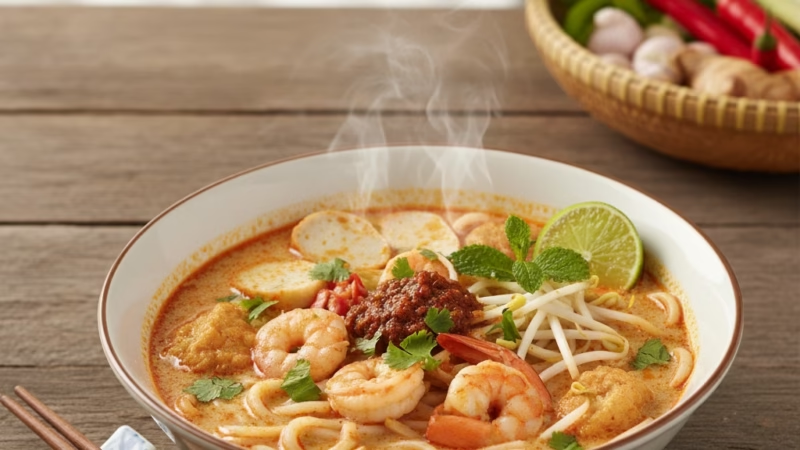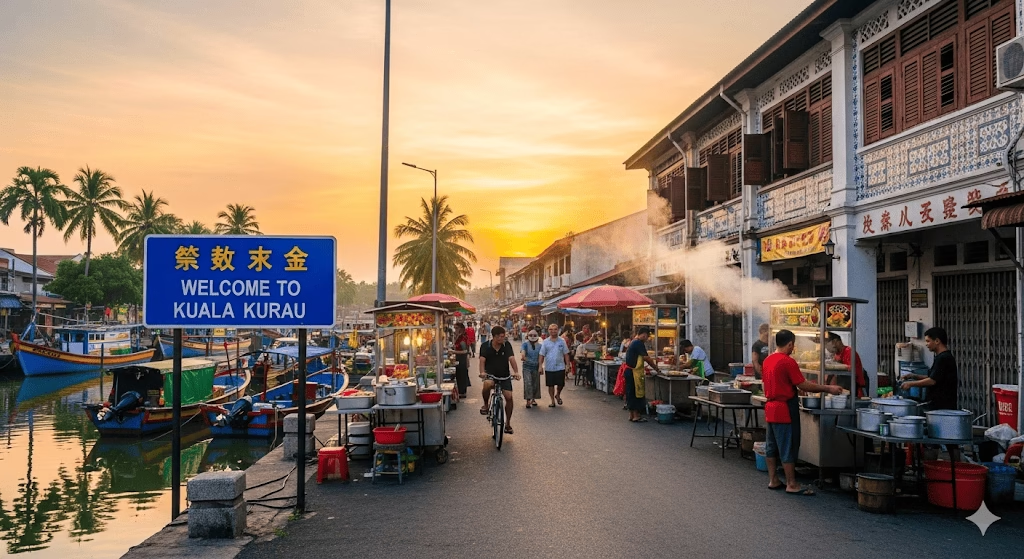Laksa

Item / Food Item
Laksa – a spicy noodle soup popular in Malaysia, Singapore, and Indonesia, combining noodles, aromatic broth, protein, and herbs.
Origin
Southeast Asia, particularly Malaysia, Singapore, and Indonesia, with Peranakan (Straits Chinese) cultural roots.
Category
Traditional Southeast Asian Dish / Noodle Soup
Appearance
A visually striking dish with vibrant orange-red or yellow broth, noodles, seafood or chicken, garnished with fresh herbs, lime, and boiled eggs.
Ingredients
- Noodles: rice vermicelli or thick rice noodles
- Protein: shrimp, chicken, tofu, or fish
- Laksa paste: chili, lemongrass, galangal, turmeric
- Coconut milk or tamarind (for Asam Laksa)
- Bean sprouts, boiled eggs
- Fresh herbs: coriander, Vietnamese mint
- Lime for garnish
Preparation
- Sauté laksa paste in oil
- Add coconut milk or tamarind-based broth
- Cook proteins (shrimp, chicken, tofu)
- Boil noodles separately
- Combine noodles, broth, and protein in bowls
- Garnish with herbs, lime, and boiled eggs
Equipment
- Cooking pot
- Frying pan
- Knife and cutting board
- Ladle
- Serving bowls
Variations
- Curry Laksa: Rich coconut milk-based spicy soup
- Asam Laksa: Tangy tamarind-based broth with mackerel
- Sarawak Laksa: Signature Malaysian variant with spiced chicken broth
- Vegetarian or seafood-only options
Taste
Laksa is spicy, tangy, creamy, and slightly sweet. The coconut milk adds richness, while the spices provide a bold, aromatic punch.
Texture
- Soft and chewy noodles
- Tender shrimp or chicken
- Crunchy bean sprouts
- Creamy boiled eggs
Aroma
Fragrant and inviting, with lemongrass, galangal, turmeric, and fresh herbs creating a complex, warm scent.
Sound
The gentle simmer of the broth and occasional sizzle of sautéing paste contribute to the sensory experience.
Cultural Significance
Laksa represents Peranakan heritage, symbolizing the fusion of Chinese and Malay culinary traditions. It is a dish often enjoyed during festivals and communal gatherings.
Symbolism
Laksa embodies harmony and cultural fusion, reflecting Southeast Asia’s multicultural history.
Regional Cuisine
- Penang Asam Laksa: Sour, tangy, and refreshing
- Singapore Laksa: Rich coconut-based soup with prawns
- Sarawak Laksa: Herbal, spiced chicken broth with noodles
Social Context
Often enjoyed in hawker centers, street stalls, and family gatherings, Laksa is both everyday comfort food and a festive dish.
Nutritional Information
- Proteins from seafood, chicken, tofu
- Carbohydrates from noodles
- Vitamins and antioxidants from herbs and vegetables
Health Benefits
- Boosts metabolism due to chili
- Anti-inflammatory effects from turmeric and galangal
- Healthy fats from coconut milk in moderation
Dietary Restrictions
- Can be made vegetarian or vegan
- Gluten-free if rice noodles are used
- Adjustable spice level
Allergens
- Seafood (shrimp, fish)
- Eggs
- Soy (tofu)
Cost
Moderate; varies by ingredients and location. Street versions are more affordable than restaurant versions.
Production
Mostly handmade in local kitchens, with fresh ingredients and traditional spice pastes. Packaged instant versions also exist.
Sustainability
Using locally sourced ingredients and seasonal seafood helps make Laksa more sustainable.
Availability
- Widely available in Malaysia, Singapore, Indonesia, and Southeast Asian restaurants worldwide
- Instant Laksa packets available in supermarkets
History
Originated from Peranakan culture, a blend of Chinese and Malay traditions. The name “Laksa” may derive from the Sanskrit word “Laksha,” meaning “many,” referring to the many ingredients in the dish.
Anecdotes
- Traditionally served during festivals and family gatherings.
- Each region has its unique take, reflecting local flavors and ingredients.
How to Prepare
- Prepare the broth: Sauté laksa paste and add coconut milk or tamarind broth.
- Cook protein: Add shrimp, chicken, or tofu.
- Boil noodles separately.
- Assemble: Place noodles in a bowl, pour the broth and protein on top.
- Garnish: Add fresh herbs, lime, bean sprouts, and boiled eggs.
FAQ
Q1: What is the difference between Curry Laksa and Asam Laksa?
A: Curry Laksa has a rich coconut milk-based spicy broth, while Asam Laksa is tangy, tamarind-based, and usually includes mackerel fish.
Q2: Can Laksa be made vegetarian?
A: Yes, by omitting seafood and chicken and using tofu or vegetables.
Q3: Is Laksa spicy?
A: Traditional Laksa is moderately to highly spicy, but spice levels can be adjusted.
Q4: Where can I try authentic Laksa?
A: Penang (Malaysia), Singapore, and Sarawak offer regional authentic versions.
Q5: How long does it take to make Laksa?
A: About 45–60 minutes, depending on the type and ingredients.















Comments are closed.